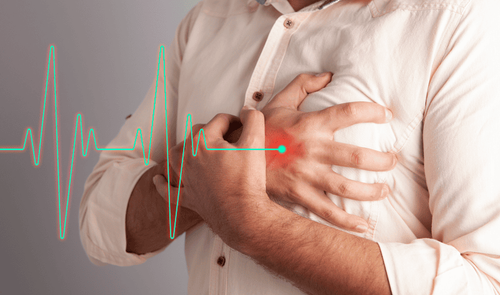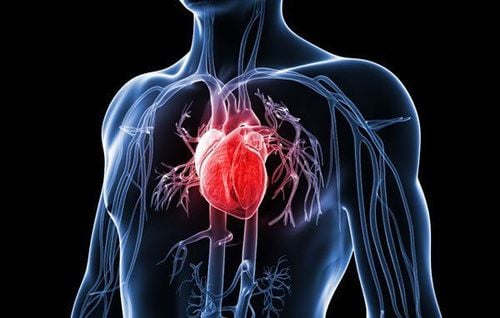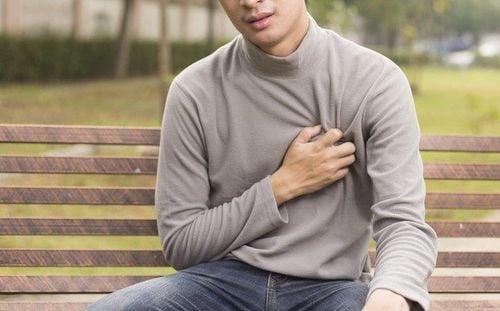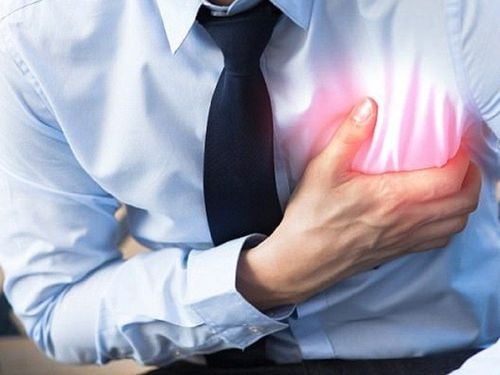This is an automatically translated article.
Article written by Doctor Le Van Binh - Department of Intensive Care - Vinmec Times City International Hospital
Heart injury most commonly occurs after a motor vehicle accident, after a high fall, or after a traumatic injury. The force directly damages the heart due to the maximal distension of the ventricular chambers during diastole, the indirect force causes a sudden increase in cardiac preload from the vena cava and extremity veins. The deceleration mechanism (due to inertia) can tear the heart valves, myocardium, and coronary arteries.
1. WHAT IS HEART INjury and HOW MECHANISM?
Trauma and trauma to the heart is a rare but not uncommon type of injury. As a serious emergency, if not diagnosed and treated promptly, it is very easy to die. In recent years, thanks to the rapid means of transportation, many lives have been saved, including gas injuries.
There are many causes of heart injury such as stabbing knife, bullet or shrapnel, closed trauma, electric shock, cardiac arrest during resuscitation... Based on the nature of the wound and the severity of the injury. , can be classified into the following three categories: puncture wounds, fire injuries, and blunt trauma.
Stab wounds are the most common: knives, bayonets, scissors or spikes. The lesions caused are usually compact, localized, sometimes penetrating the heart (with holes in and out), damaging the internal organs of the heart such as the valve ligaments, the leaflets, the atrial septum. or interventricular.
Fire wounds are the type of wound that occurs in both war and peacetime. The damage caused is often much more severe than the above type because of the breaking force and the edge of the wound is crushed, not counting the cases of foreign bodies entering the body causing thromboembolic complications.
Closed trauma is a less common type of injury, mainly not because of the rate but because of the ability to diagnose and miss patients.
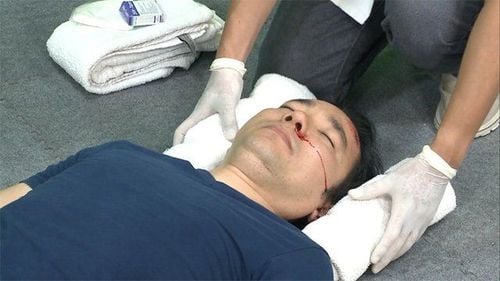
2. CLINICAL
Regarding the clinical picture, it can be divided into two main categories: the type that causes bleeding with the main sign being hemorrhagic shock, and the type that causes acute cardiac tamponade.
2.1. Type of bleeding: The patient was admitted to the hospital with signs of hemorrhagic shock: pale, lying still, fast, small pulse, low blood pressure. Blood can leak out through the skin wound, but it can also only flow into the pleura causing hemothorax.
Patients usually have an open chest wound (either by a sharp object or by a gas): the pericardium is perforated, blood flows from the heart chambers into the pericardium, then from the pericardium through the perforation into the pleura or out through the chest wall. In the case of bleeding into the pleura, the clinical manifestation is an uncontrollable pleural hemothorax, conservative treatment (drainage, continuous aspiration) often fails to yield results, when emergency thoracotomy will be detected. have a heart attack. Sometimes blood from the pericardium flows straight out through the chest wall wound but not through the pleura, this is because the wound is located in an area where there is no pleural space (in front of the chest close to the left breastbone).
The location of the wound has a great value for suspecting a heart injury: the triangle is bounded by the sternum and the left nipple. However, the diagnosis should not be based on the location of the wound alone. X-ray: if possible, it should be taken standing: when there is air in the pericardium, it is certain. The sign of two interlocking balls is hard to see. The heart shape is usually not large. When shooting in the lying position, the reading of the film must be more cautious. Auscultating auscultation: not yielding valuable findings, an abnormal murmur may be seen in individuals previously determined to be absent, which indicates an interventricular septal defect. Electrocardiogram: the most common sign is ST-segment elevation in the leads Ultrasound: signs of pericardial effusion. In short, standing in front of a victim with signs of blood loss, a wound in the heart area, it is necessary to immediately think of a heart injury.
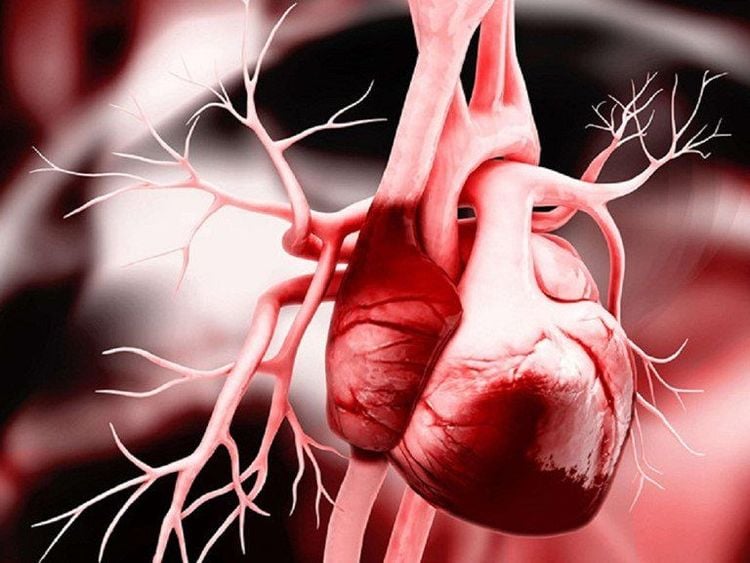
2.2. The type that causes acute cardiac tamponade Blood that flows into the pericardium does not escape (into the pleura or to the skin) will cause acute tamponade syndrome. This syndrome occurs when the pericardium is not torn (common in blunt trauma), or there is a perforation (found in penetrating wounds) but the blood clot has blocked. The pressure in the pericardial cavity is increasing due to blood flowing from the heart chambers, causing obstruction during diastole: the heart cannot suck blood from the veins, so the blood pumped from the ventricles also decreases, the patient will have signs : struggling, purple face, shortness of breath, prominent neck veins. Arterial blood pressure decreases, the maximum - minimum distance narrows, the rapid pulse is small. Venous blood pressure is elevated. Reverse circuit sign. Auscultation of the heart usually shows nothing special, can see a small heart sound. X-ray: because the pericardium is suddenly stretched, the size is not large enough, the heart shape is almost unchanged. Some authors have suggested that the cardiac margin is more prominent due to the restricted cardiac movement, but it is difficult to identify. Electrocardiogram: ST segment elevation. The cardiac potential does not decrease. Pericardial puncture: is a valuable diagnostic measure. Usually the Marfan line is used to poke the patient in the Fowler position. The aspirated blood does not clot, but in some cases it can still clot. To avoid cardiac catheterization and also to avoid confusion with blood aspirated from the chamber, a precordial lead should be used immediately connected to the puncture needle, so that it will be known when the needle is touching the myocardium. The diagnosis of a hemopericardium in blunt chest trauma is often missed. In the case of a fracture of the sternum, it is a very valuable suggestion.
3. TREATMENT
In the past, when faced with a case of a heart injury, most authors suggested conservative treatment: pericardial aspiration, compensatory blood transfusion, in the hope that the wound would heal on its own. But since the 1960s, the trend of suturing surgery has become more and more accepted, and today has become the treatment with the best results. However, in conditions of inability to operate, pericardial aspiration is a method of treatment that gives results up to 80-90%Incision: usually, it is recommended to use the incision through the left 5th intercostal space, when It is necessary to transverse the sternum to the right. The sternal incision is a broad line that can easily treat most cardiac injuries, but requires familiarity and assurance of sterility.
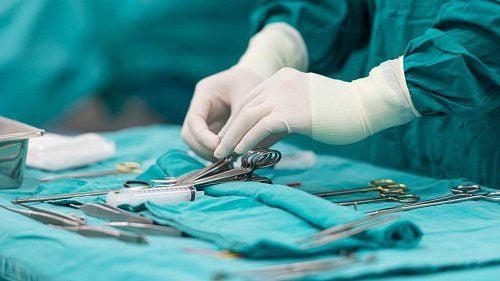
If the heart wall is punctured and requires suturing, the stitches must not injure the major coronary arteries. Foreign body in the heart: if it is intracardiac and mobile, it must be removed immediately. Only a heart-lung machine can be operated on to ensure a sure result. In the case of an immobilized foreign body, it can be a delayed emergency, as it is likely that the foreign body will drift away at any time. When the foreign body is in the outer wall of the heart, it can be surgically removed without the need for a cardiopulmonary machine. Injuries inside the heart: the walls of the chambers of the heart, the valves of the heart (valves, ligaments, etc.) if they do not cause a major hemodynamic disturbance, then the emergency time should be left out, ie. Only after the wound has recovered from the pericardial wall will surgery be performed. Coronary wound: if in large trunks, it is necessary to reconnect to avoid complications of myocardial infarction. Of course, it is necessary to use a cardiopulmonary machine, which can be sutured directly or grafted a segment of the saphenous vein. Results after surgery: generally depends on the nature of the wound due to sharp objects or gas), the time from the time of injury to hospital arrival. For puncture wounds, the pre-hospital mortality rate is about 20%, due to arson is 80%. The results after surgery for stab wounds are also much better. At the Vietnam-Germany Friendship Hospital, only those who are still alive come to the hospital, only 1 in 16 cases of death from a sharp object's wound, on the contrary, only 1 in the total number of people who have survived due to fire. 9 cases. The blunt trauma type has a higher mortality rate, because the damage is much more severe and complex. To protect heart health in general and detect early signs of myocardial infarction and stroke, customers can sign up for the Cardiovascular Screening Package - Basic Cardiovascular Examination of Vinmec International General Hospital. The examination package helps to detect cardiovascular problems at the earliest through tests and modern imaging methods. The package is for all ages, genders and is especially essential for people with risk factors for cardiovascular disease.
If there is a need for consultation and examination at the Hospitals of the national health system, please book an appointment on the website to be served.
Please dial HOTLINE for more information or register for an appointment HERE. Download MyVinmec app to make appointments faster and to manage your bookings easily.
MORE
The dangers of pericardial effusion Diagnosing pericardial effusion Decoding common chest pain





